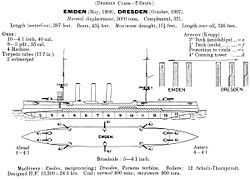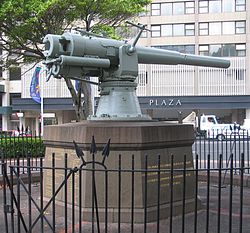 SMS Dresden transiting the Kaiser Wilhelm Canal | |
| Class overview | |
|---|---|
| Builders | Blohm & Voss and Kaiserliche Werft Danzig |
| Operators | |
| Preceded by | Königsberg class |
| Succeeded by | Kolberg class |
| Built | 1906–1909 |
| In service | 1908–1915 |
| Completed | 2 |
| Lost | 2 |
| General characteristics | |
| Type | Light cruiser |
| Displacement | |
| Length | 118.30 m (388 ft 1 in) |
| Beam | 13.50 m (44 ft 3 in) |
| Draft | 5.53 m (18 ft 2 in) |
| Installed power |
|
| Propulsion |
|
| Speed | 24 knots (44 km/h; 28 mph) |
| Complement |
|
| Armament |
|
| Armor |
|
The Dresden class was a pair of light cruisers built for the Imperial German Navy in the early part of the 20th century. The class comprised SMS Dresden, the lead ship, and SMS Emden. Both ships were laid down in 1906; Dresden was launched in 1907, and Emden followed in 1908. They entered service in 1908 and 1909, respectively. The design for the ships was an incremental improvement over the preceding Königsberg class, being slightly larger and slightly faster, but with the same primary armament of ten 10.5 cm (4.1 in) guns. Dresden and Emden were powered by steam turbines and triple expansion engines, respectively, as part of continued experiments with the new turbine technology.
Contents
- Design
- General characteristics and machinery
- Armament and armor
- Construction
- Service history
- Dresden
- Emden
- Notes
- References
- Further reading
Both ships served extensively on foreign stations; Emden was assigned to the East Asia Squadron from her commissioning, and Dresden was sent to Caribbean waters in 1913. Dresden was due to return to Germany for periodic maintenance shortly before the outbreak of World War I in August 1914, but this became impossible with the onset of hostilities. She therefore operated as a commerce raider, before linking up with Vizeadmiral Maximilian von Spee's East Asia Squadron. Dresden thereafter participated in the Battle of Coronel in November 1914 and the Battle of the Falkland Islands the following December. She was the only German vessel to escape destruction at the latter engagement, and she remained at large for several more months. Dresden finally put into the Chilean island of Más a Tierra in March 1915 owing to worn-out engines. A pair of British cruisers violated Chilean neutrality and attacked Dresden while she lay at anchor; the Germans scuttled their ship to prevent her capture.
Emden, meanwhile, had been detached from the East Asia Squadron to pursue an independent commerce raiding campaign in the Indian Ocean. She captured or sank numerous Entente vessels, including the steamer Ryazan which was converted into the auxiliary cruiser SMS Cormoran. In September 1914, Emden raided Penang and caught the Russian protected cruiser Zhemchug and the French destroyer Mousquet and quickly destroyed both ships. Shortly thereafter, Emden was caught by the Australian cruiser HMAS Sydney off the Cocos Islands and forced to beach after a ferocious engagement.



